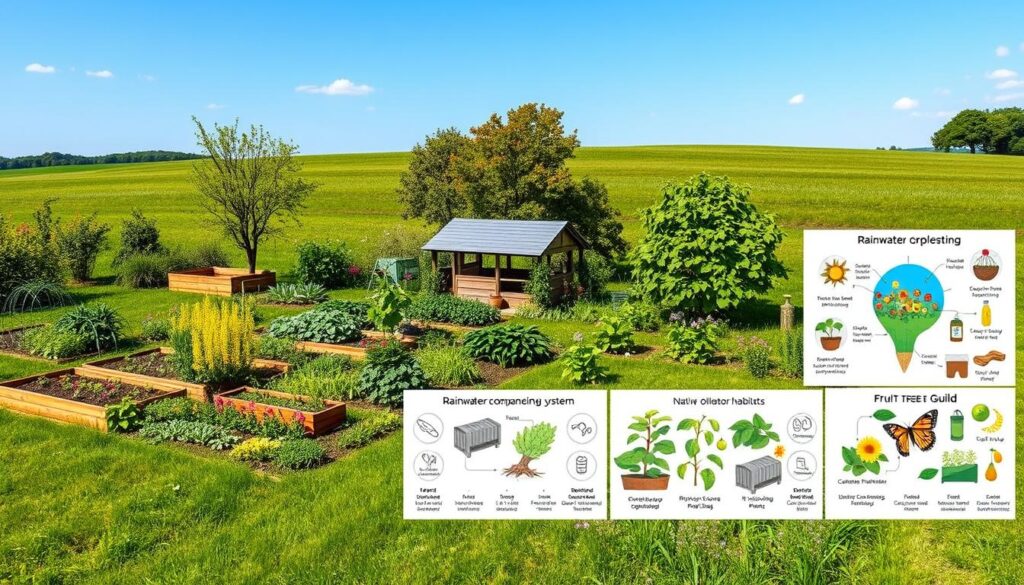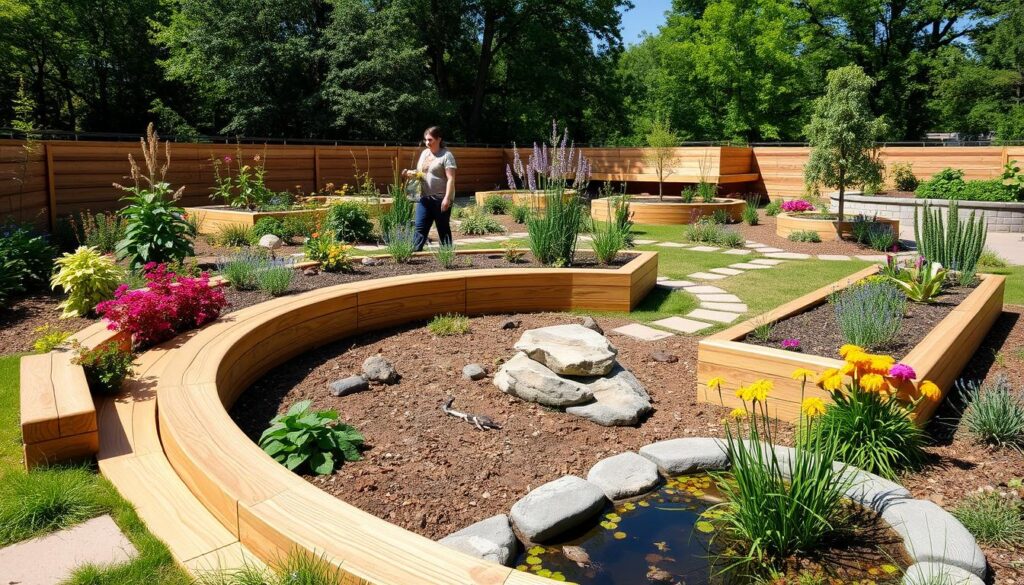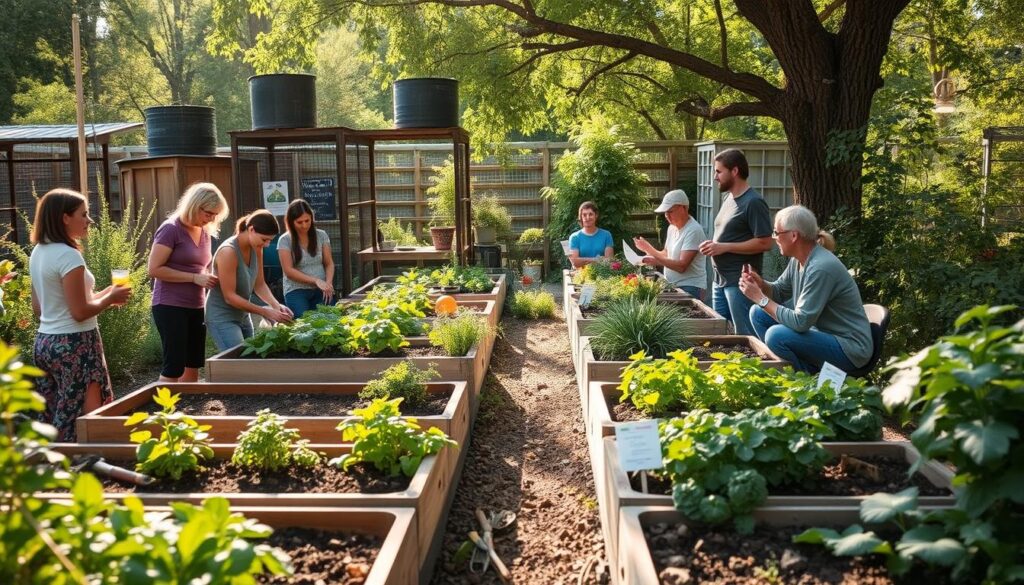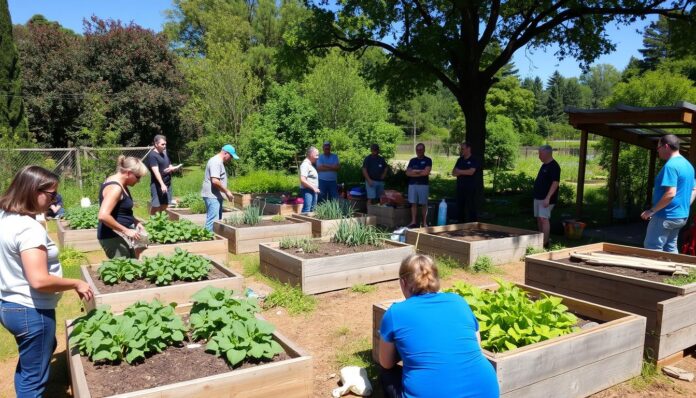What if teaching permaculture to adults could lead to a greener future? As more people seek sustainable living courses, finding the best ways to teach permaculture is key. Adult permaculture education is crucial for spreading the word about living sustainably and caring for our planet. It can inspire adults to help their communities in meaningful ways.
Looking into adult permaculture education, we see it can take many forms. This includes workshops, courses, and community projects. These programs give adults the tools to live more sustainably. By focusing on these efforts, we can build a greener world for all.
Key Takeaways
- Adult permaculture education is essential for promoting sustainable living and environmental awareness.
- Dynamic curiosity and an active approach to learning are crucial for effective permaculture education.
- Sustainable living courses can empower adults to make a positive impact on their communities.
- Adult permaculture education can take many forms, including workshops, courses, and community-based initiatives.
- By focusing on adult permaculture education, we can work towards a more environmentally conscious future.
- Permaculture education emphasizes a growth in both plant cultivation and nutritional knowledge.
- Adults can benefit from learning about regenerative solutions for local energy, food, water, and waste management.
Understanding Adult Learning Principles
Adult learning is different from learning as a child. Adults have a lot of experience and knowledge. This can help or make learning harder. To teach permaculture to adults well, we need to know how adult learning works.
Key Theories in Adult Education
Adult education is based on theories like andragogy, self-directed learning, and experiential learning. These theories stress the value of learner freedom, experience, and doing things hands-on. Experiential learning programs are great for permaculture because they let learners use what they learn in real situations.
Differentiating Adult Learners from Children
Adults and children learn in different ways. Adults learn on their own and want to use what they learn in real life. Children need more help and motivation. Teachers should design lessons for adults that fit their learning style.
The Role of Experience in Learning
Experience is key for adult learning. It helps build new knowledge and skills. Ecological literacy classes help adults understand nature and their role in it. Using experiential learning and ecological literacy in permaculture education makes learning fun and effective for adults.
Experiential learning programs and ecological literacy classes offer many benefits. These include:
- Keeping knowledge better and using it more
- Making learners more engaged and motivated
- Improving critical thinking and solving problems
- Understanding ecological principles and practices better
The Importance of Permaculture Education
Permaculture education is key to living sustainably and protecting our environment. By joining permaculture design workshops, people learn how to create and care for productive ecosystems. This knowledge is essential for adopting regenerative agriculture training methods, which help reduce farming’s environmental harm.
Permaculture’s closed-loop system means less need for outside help. This makes it a great choice for those wanting to lower their carbon footprint. Since 18% of U.S. carbon output comes from farming, learning permaculture is very important.
To learn more about permaculture and sustainable living, check out permaculture education resources. By taking part in permaculture workshops and training, we can build a greener future.
Designing Effective Permaculture Curriculum
Creating a permaculture curriculum means making sure it matches the learning goals. This way, students get a full grasp of permaculture’s basics and how to apply them. Hands-on sustainable practices are key, letting students use what they learn in real life.
A good permaculture course mixes theory and practice. This gives students a complete view of sustainable living. Environmental education seminars are great for teaching permaculture. They let students learn from experts and their experiences.

Some top permaculture programs use project-based learning. This makes learning fun and helps students remember what they learn. These programs also teach students to connect with nature and plan for a sustainable future.
Important parts of a permaculture curriculum include:
- Linking permaculture education with school standards
- Hands-on experience with sustainable practices
- Focus on environmental education and awareness
Engaging Different Learning Styles
Adult permaculture education focuses on different learning styles. This ensures everyone can learn and apply what they learn. People learn in various ways, like seeing, hearing, or doing.
For sustainable living courses, using many teaching methods helps a lot. Visual learners get a lot from diagrams and videos. Auditory learners do well with talks and audio. Kinesthetic learners enjoy hands-on activities.
Technology is also key in learning. Online tools and apps offer interactive lessons and games. These make learning fun and fit for everyone’s style. This way, learning becomes more inclusive and effective.
This approach helps people learn to live sustainably. It teaches them to care for the earth and build community. It’s a step towards a greener future.
Outdoor Learning Spaces and Their Benefits
Outdoor learning spaces have many benefits for students. They help students focus better, manage themselves, and improve their social skills. By using experiential learning in permaculture education, students get to work directly with nature. This method helps them understand ecological principles better and builds a strong connection with the environment.
Setting up permaculture demonstration sites is a great way to teach students about sustainable gardening and managing ecosystems. These sites become outdoor classrooms where students can do hands-on activities like planting, harvesting, and composting. Through these activities, students learn teamwork, problem-solving, and critical thinking.

When designing outdoor learning spaces, safety is key. It’s important to check the terrain, weather, and potential dangers like wildlife or toxic plants. By considering these factors, educators can make a safe space for students to explore and learn. This approach makes permaculture education more engaging, effective, and sustainable.
- Increased focus and self-regulation
- Improved social skills, such as teamwork and communication
- Enhanced ecological literacy through hands-on experience
- Development of essential skills, including problem-solving and critical thinking
Collaborative Learning Approaches
Collaborative learning is becoming more popular in permaculture education. It focuses on group work and learning from each other. Through permaculture design workshops, people can learn more about regenerative agriculture.
Studies show that groups understand things better than individuals. This proves that working together is effective. It also builds a sense of community and teamwork, key for regenerative agriculture training.
The Power of Group Work in Permaculture
Group work in permaculture education boosts participation, thinking, and solving problems. When people work together, they share knowledge and skills. This leads to a better grasp of permaculture principles.
Facilitating Peer-to-Peer Learning
Peer-to-peer learning is a big part of collaborative learning in permaculture. It lets people learn from each other and share experiences. Educators help create a supportive and welcoming space for this.
- Encourages active participation and engagement
- Fosters a sense of community and cooperation
- Develops critical thinking and problem-solving skills
By using collaborative learning, permaculture education becomes more effective and fun. People working together can understand regenerative agriculture better. This helps build a sustainable food system for the future.
Incorporating Cultural Perspectives
Adding cultural views to permaculture education is key. It means learning about indigenous ways and valuing diversity in learning spots. This makes learning more welcoming and useful. For example, environmental education seminars can be made to fit different cultures. They teach sustainable practices that matter to each group.
Some important steps for adding cultural views to permaculture learning are:
- Understanding the cultural value of land and nature
- Respecting old practices and knowledge
- Making learning spaces that welcome all cultures
By adding cultural views, we make permaculture learning more complete and effective. This is done through hands-on sustainable practices and environmental education seminars that meet each community’s needs. As we go on, we must focus on being culturally sensitive and inclusive in permaculture education.

Assessment Methods for Adult Learners
Adult permaculture education focuses on curiosity and active learning. In sustainable living courses, how we assess learning is key. Adult learners need a mix of formative and summative evaluations to show they’ve learned.
Formative vs. Summative Assessment
Formative assessments check on learning progress. Summative assessments look at the final results. In permaculture, both are needed to see if learners have reached their goals. Hands-on activities and projects are great for checking understanding.

Practical Assessments in Permaculture Education
Practical assessments let learners use what they’ve learned in real life. This helps them solve problems and think about sustainable living. Feedback is also key for growth, helping learners see where they can improve.
Feedback Mechanisms for Continuous Improvement
Feedback, like from peers and self-assessment, is crucial for getting better. It helps learners improve their skills and knowledge. This way, adult permaculture education helps learners make a difference in their communities.
Promoting Lifelong Learning in Permaculture
Permaculture education is all about learning for life. It’s a field that keeps growing. To help with this, experiential learning programs are great. They let people learn by doing in permaculture.
Ecological literacy classes are also key. They teach the basics of nature and how to apply them in permaculture. Together, these methods help people really get permaculture. They learn how it can make ecosystems strong and green.
Strategies for Encouraging Self-Directed Learning
Learning on your own is vital in permaculture. Here are some ways to support it:
- Give people access to more learning materials
- Help them meet and work with other permaculture fans
- Let them decide what they want to learn
Creating Resources for Continued Education
It’s important to make learning tools for all permaculture learners. This can be online courses, workshops, and books. They should cover topics like experiential learning programs and ecological literacy classes.
Challenges in Adult Permaculture Education
Adults face many hurdles in learning permaculture, like overcoming resistance to new ideas. They also deal with time and money issues. Taking part in permaculture workshops is a big step towards learning regenerative farming. But, the cost and time needed can stop many from joining.
Some of the challenges can be outlined as follows:
- Overcoming resistance to change: Many adults may be set in their ways and resistant to new ideas, making it challenging to adopt permaculture principles.
- Addressing time constraints: Adult learners often have busy schedules, making it difficult to find time for permaculture education and practice.
- Financial barriers: The cost of permaculture design workshops and regenerative agriculture training can be prohibitively expensive for some individuals.
Despite these challenges, more people are interested in permaculture and regenerative farming. By understanding these challenges and finding ways to solve them, we can make learning permaculture easier for adults.
By offering flexible and affordable workshops, we can help adults adopt sustainable practices. This way, they can contribute to a greener future.
| Challenge | Strategy |
|---|---|
| Resistance to change | Offer introductory workshops, provide testimonials from previous participants |
| Time constraints | Offer online courses, flexible scheduling for in-person workshops |
| Financial barriers | Offer scholarships, sliding scale fees, payment plans |
Utilizing Online Learning Platforms
Online learning platforms are key in permaculture education. They offer a flexible way to learn about sustainable practices and environmental seminars. These platforms have video lessons, quizzes, and forums to help learners on their permaculture path.
Digital education in permaculture reaches more people, including those in remote areas. Online courses let learners go at their own pace. This makes learning about sustainable practices and seminars easier and more convenient.
Some top online courses and resources for permaculture include:
- Permaculture Design Certificate (PDC) courses
- Online workshops and webinars on topics like regenerative agriculture and sustainable living
- Environmental education seminars and conferences
It’s important to mix online learning with hands-on experience. Permaculture needs direct interaction with nature. By combining online learning with practical experience, learners can deeply understand permaculture and develop needed skills.
Online learning platforms are a great resource for permaculture education. They offer many courses, resources, and community support. By using these platforms and balancing online learning with practical experience, learners can gain the knowledge and skills for a sustainable future.
| Online Course | Description |
|---|---|
| Permaculture Design Certificate (PDC) | A comprehensive course covering permaculture principles and design |
| Regenerative Agriculture | A course focusing on sustainable agriculture practices and soil regeneration |
| Environmental Education Seminars | A series of seminars on environmental topics, including conservation and sustainability |
Engaging with Local Communities
Getting involved with local communities is key in adult permaculture education. By working with community groups, hosting workshops, and encouraging volunteering, people can learn by doing. This helps both the community and lets people share what they know.
In places like Portland, the City Repair Project uses volunteers for community projects. In Brisbane, the Northey Street City Farm has become a food source and learning place. These show how important community help is for sustainable living and learning permaculture.
By taking part in sustainable living courses, people can learn to make a difference. They can learn about growing food without harming the earth and how to save water. Working together, we can build a better future.
- Hosting workshops and events on sustainable living practices
- Encouraging volunteer opportunities in local permaculture projects
- Building partnerships with community organizations to promote adult permaculture education
Using these methods, people can help their communities grow. They also help spread the word about sustainable living and permaculture education.
Evaluating Program Effectiveness
When looking at permaculture education programs, it’s key to focus on experiential learning and ecological literacy. These approaches help students grasp permaculture principles better. They also learn how to use these principles in real life.
Some important things to think about when checking if a program works well include:
- How much students are involved and participate
- How well they remember and use what they learn
- How well they understand and see the world around them
- How involved they are with their community
A good way to check how well a program is doing is to look at what works and what doesn’t. This helps make the program better for the future. By adding experiential learning and ecological literacy, permaculture education can really make a difference.
A study showed that students who took part in hands-on learning did much better. They got better at understanding the environment and were more involved in their communities. This study also showed how important it is to reach out to the community.
| Program Component | Effectiveness Rating |
|---|---|
| Experiential Learning Programs | High |
| Ecological Literacy Classes | High |
| Community Involvement | Medium |
By checking how well programs work and listening to students and the community, permaculture education can keep getting better. This leads to a more sustainable and strong future for all of us.
The Role of Policy in Permaculture Education
Permaculture design workshops and regenerative agriculture training are key parts of learning permaculture. They teach people how to create and care for sustainable ecosystems. This helps protect the environment and builds stronger communities. Policy is important in shaping these learning experiences.
It’s vital to advocate for permaculture in schools. Working with governments can help fund these programs. This way, we can all work towards a greener future and make permaculture education a big part of learning for adults.
- Supporting permaculture design workshops and regenerative agriculture training programs
- Encouraging collaborations between government entities, educational institutions, and permaculture organizations
- Promoting environmental awareness and sustainability through permaculture education
By focusing on permaculture education, we can make our community more eco-friendly and strong. Workshops and training in permaculture and regenerative agriculture are crucial. Policy is key in supporting these efforts.
Future Trends in Adult Permaculture Education
The need for sustainable practices is growing fast. Adult permaculture education is set to change to meet these needs. New teaching methods, like virtual reality and gamification, will make learning more hands-on. Climate change will also influence education, focusing on practical, regenerative solutions.
Innovations in Teaching Methods
Permaculture teachers are looking into virtual reality for interactive learning. It lets students explore real-world systems without physical limits. Gamification makes learning fun and competitive, helping learners apply permaculture in a playful way.
The Impact of Climate Change on Education Approaches
Climate change will force permaculture education to adapt. Courses will focus on practical solutions for food, water, and energy. Workshops and seminars will empower adults to build sustainable communities.
Expanding Global Networks in Permaculture Education
Adult permaculture education will also grow globally. Online platforms will share knowledge worldwide. This will help in learning from diverse perspectives, shaping the future of permaculture.

